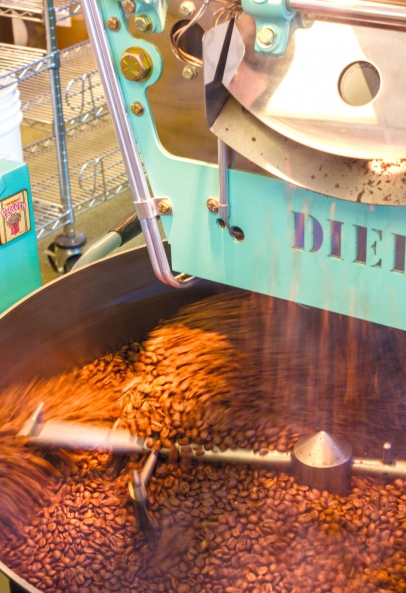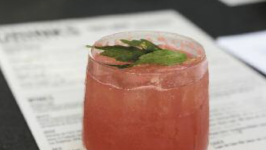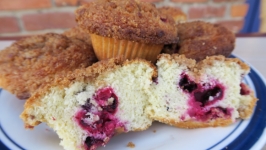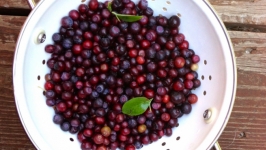Roast of the Town
Even before she became a coffee drinker, Liz Roquet, owner and roaster at Lizzy's Fresh Coffee in Ketchum, recognized that coffee had a special power to bring people together. The daughter of a konditor, an Austrian baker, Roquet grew up around her family's cafe in Ketchum, where she saw customers gather daily for coffee and cake. The afternoon ritual, a tradition adopted from Europe, brought people together around a decidedly pleasurable occasion. As a result, since childhood, Roquet has associated coffee with happiness and connection. "Coffee has always been a joy for me," she says.
Roquet became more attached to coffee culture during visits to her family in Austria. There, she took part in the tradition of afternoon coffee and cake at its roots, the great coffee houses and small-town cafes of Europe. "I really got into coffee culture," she says, having enjoyed the ritual with her family at a Kitzbuhel, Austria cafe. Roquet recalls there being something special on those European coffee excursions – a genuine pleasure in the experience that was harder to find in the United States.
Though coffee remained a part of Roquet's life (including home roasting as a hobby with husband Lee), she didn't become professionally involved in the industry until 2008. At that time the outdoor apparel company she had worked for was relocating their offices to another state, and Roquet wanted to stay in the Wood River Valley. She hadn't previously considered a career in coffee, but when she found herself looking for new opportunities, "it seemed like the obvious, natural choice," she says. "I decided to combine my background in business with my love for coffee and the joy I found in it."
With limited experience roasting coffee, Roquet knew she had to learn professional roasting techniques (a long way from the popcornpopper method she'd used at home). The training process is ongoing, she says, and one of the things that keeps her engaged and enthusiastic about her profession. "I continue to improved my craft," she explains. taking classes, pursuing certifications, and learning from colleagues at industry events. "It's a team collaboration," Roquet says of the exchange of ideas among colleagues – another instance where people are pulled together around coffee.
Just as Roquet has found a community through collaboration with other roasters, she's also entered into the global community of the coffee industry. When her son, Cooper (in elementary school at the time), created a project where he and his classmates raised money for soccer jerseys for a youth team in a coffee-growing community in Colombia, Roquet was invited to visit the region.
As he studied the world map at the roasting company, Cooper had become curious about the lives of kids his age in the places marked as coffee-growing regions. When Roquet explained that many of these children didn't have the same resources that Cooper and his friends enjoyed, Cooper wanted to do something to help. So, along with Roquet, Cooper and his classmates decided they would sell a line of coffee to raise money for jerseys for a soccer team in a town in Colombia that produces some of the beans Roquet uses. Cooper and his classmates designed labels for the coffees, and with the proceeds, they were able to buy jerseys for the Colombian team.
As a surprise result of their successful project, Roquet was invited to Colombia to present the team jerseys and to participate in as judge in a coffee "cupping" competition (where experts taste and evaluated coffees). This was her first "origin trip" – the first of many, she hopes. "Nothing compares to the experience of going to origin, to pulling a coffee bean straight off the shrub," Roquet says. With first-hand experience, she also was able to connect with the people involved with the production end of coffee – the farmers and their families. "It really made me feel like I was part of the community," she says of her connection to this particular growing region in Colombia, and recognition of the coffee industry as a global community.
It would seem that from Roquet's early coffee experiences in her family's cafe to the international coffee connections she's made, relationships are ultimately what has made coffee special for her. While she knows what goes into a quality cup, the real joy of coffee is the people connected to that cup, whether a friend sitting across the table or farmer thousands of miles away.
Coffee with a Cause
What makes a great cup of coffee even better? As Roquet sees it, when coffee helps support a worthy cause. With Lizzy's Fresh Coffee's "Giving Beans" program, a coffee can be designated to a particular cause, and a portion of those sales will benefit that cause. "Everyone has something they can share," she says of her community involvement. "I have this vehicle, so I want to use it to contribute what I can." Local organizations that have benefited from Giving Beans include the Sun Valley Ski Education Foundation and the Animal Shelter of the Wood River Valley. Learn more about Giving Beans.
The Perfect Cappuccino
These days there's an infinite variety of ways to prepare and serve coffee drinks, and what you order by a certain name at one cafe may come out quite differently at another spot. So let's get back to basics with an iconic – though often misunderstood – coffee drink: the cappuccino.
Though a cappuccino may vary by the temperature of the milk or espresso, the amount of milk or the way the milk is steamed, Roquet says that she sticks to certain standards. "A cappuccino is a coffee-and-milk beverage that should produce a harmonious balance of rich, sweet milk and espresso," she explains. And to produce the perfect cup, Roquet follows "the rule of thirds": one-third coffee, onethird milk, and one-third foamed milk (you can also interpret the milk portions as two-thirds "milk foam"). The way the milk is foamed is the key; she says that the foamed milk should be "beautifully textured," not stiff, so that it all pours together with a consistency like wet paint. This is known as microtexture. Roquet serves her cappuccini in 6-ounce cups, using two shots of espresso, to which she adds microtextured foam.








